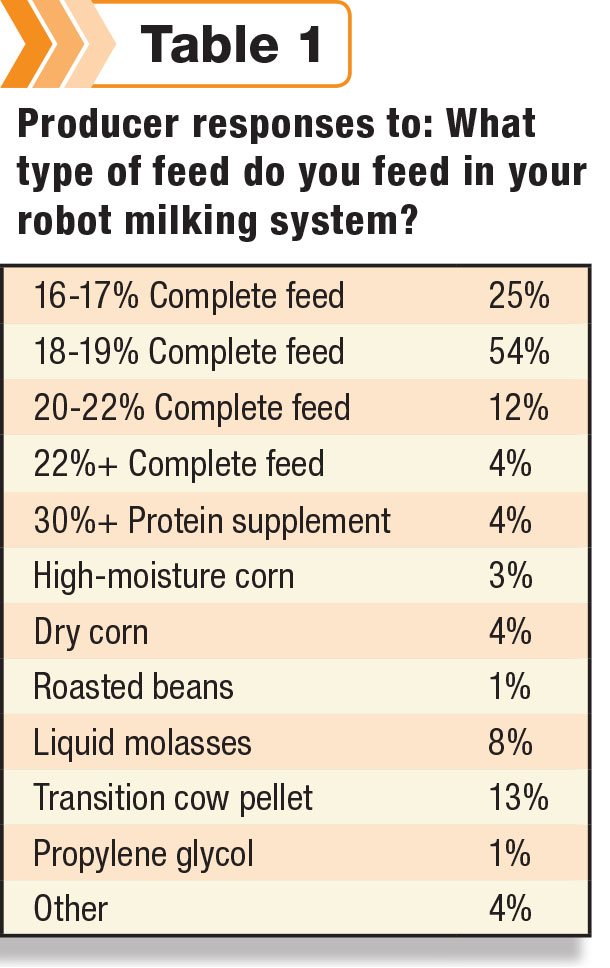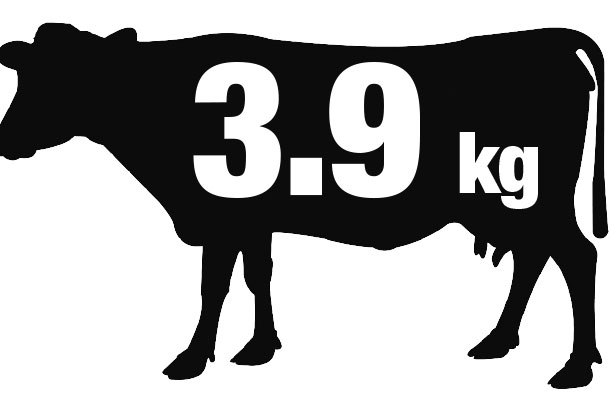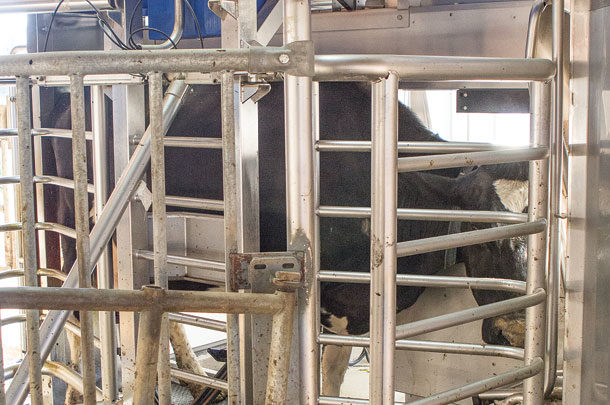One of the main differences between the two systems is the feeding management. Individual robot companies and feed companies looking to grab their share of the pie in the robot marketplace have done an excellent job of educating new robot producers on successful feeding management.
No longer are we feeding TMRs that support high milk production and cover the needs of the majority of the milking herd with one diet; rather we have focused on feeding lower-energy partially mixed rations (PMR) at the feedbunk with milk cows being individually fed varying levels of concentrate based on their milk production levels and stage of lactation at the robot.
With this change in feeding management comes many options for the producer to decide on what type of feeds will work best for their robotic operation.
A recent survey of active robotic milk producers summarized some of the feeding management decisions these producers have made.
While all robot companies offer the option of feeding multiple feeds through their robots, the survey revealed that the majority of producers (69 percent) feed only one feed type in their robots. Feeding two feed types was the second-most-preferred option (26 percent), with only 4 percent feeding three feeds and 1 percent feeding four or more.
The type of feed being used varied much more amongst producers.
While many have relied on the traditional complete feed pellets as the concentrate source, other farms have successfully been feeding alternate feed types either on their own or in combination, such as higher protein supplements, high-moisture or dry corn, roasted beans, transition/fresh cow pellets, liquid molasses, extruded soybeans, propylene glycol, barley malt sprouts and homemade grain mixes. Table 1 provides a breakdown of the feed types being fed and the percent of farmers using each one.
 Producers were also asked how much of these feeds they were feeding through the robot system on a daily basis. Farms were feeding an average of 3.9 kg per cow per day of concentrate through the robot, with more than two-thirds of farms falling within the range of 2.8 to 5 kg.
Producers were also asked how much of these feeds they were feeding through the robot system on a daily basis. Farms were feeding an average of 3.9 kg per cow per day of concentrate through the robot, with more than two-thirds of farms falling within the range of 2.8 to 5 kg.
The minimum feed a cow could get averaged 1.6 kg per cow per day (range 0.6 to 2.6), and the maximum levels were 6.8 kg per cow per day (range 3.8 to 9.8).
On a per-milking basis, cows received a minimum of 0.3 kg feed per milking (range zero to 0.7) and a maximum of 2.7 kg per milking (range 1.5 to 3.9). With the average Ontario robot farm at 92 milking cows, we can quickly calculate that farms are using about 350 kg of feed per day in their robots.
For many producers, this represented an increase in their purchased feed costs. Our survey asked farmers to “estimate the change in your purchased feed costs with the change to robotic feeding.” Producers reported a range from no increase to 50 percent increase in purchased feed costs.
Looking closer at the responses given: 21 percent of farms saw no increase, 26 percent reported a 1 to 10 percent increase, 42 percent with an 11 to 20 percent increase, 9 percent reported a 21 to 30 percent increase, while 31 to 40 percent increase and 41 to 50 percent increase each had 1 percent of producers reporting in this category.
One must remember that purchased feed costs do not tell the whole story of the farm operation or its profitability. Switching to robotic milking brings with it potential financial benefits such as increased milk production through increased milkings per day, reduction of labour costs, land available for alternate crops to generate income and reduced veterinary costs with the increased information about cow health.
However, there are some nutritional strategies robotic producers can employ to try to reduce their purchased feed costs while maintaining their desired level of performance. Many of these will come with an extra level of management required by the farm operation to be executed successfully and will have some pros and cons specific to individual operations. Let’s have a look at some of the options below.
These are just some of the many options producers have to feed their dairy cows in a robotic milking system. Many or all of these strategies are being employed on robotic dairy operations now, so leaning on your neighbour or nutrition adviser for guidance is a great place to start if you are looking for some feeding alternatives.
The traditional feeding method of feeding one standard robot pellet to all milking cows certainly provides the easiest solution for producers that are not looking for added work or are not feeling the stress of having higher purchased feed costs.
Feeding multiple feed types, some of which may be on-farm feeds or mixes, will require an increased level of management by the producer to ensure good intakes, desired performance, flow of feed, proper processing and freshness at delivery.
Some options may also require some additional capital start-up costs to allow for proper feeding and handling. These added tasks for the farm will need to be compared with the cost savings each option may provide to decide which option may be right for your operation. PD

High-moisture shell corn
Pros – Homegrown starch source cows will readily consume and highly digestible. Feeding alone or with a protein source, cow traffic should be maintained and higher levels of feed can be fed to supply the needs of the top-producing cows.
Cons – More difficult to process and handle than dry corn, high-moisture corn may have trouble flowing through some feed systems and must be processed and fed regularly to avoid heating and spoilage. Producers may need a different level of processing for feed in the PMR fed at the feedbunk and the high-moisture corn fed in the robot.
Roasted/micronized soybeans
Pros – A high-protein, high-fat feed very palatable to cows, beans can provide high-quality bypass protein that encourages milk production and components. Producers could get their own soybeans processed to feed in their robotic system.
Cons – Fat content of beans will limit the maximum that can be fed; thus, roasted beans should be fed with another grain source. Poorly processed beans will be poorly digested and will show up in the manure.
Liquid molasses
Pros – Molasses is very palatable and provides a highly digestible source of sugar cows will readily consume. It will encourage visits to the robot and may stimulate performance.
Cons – Capital costs will be incurred in order to easily feed molasses in the robot. Feeding rates will still be too low to feed as a sole source of feed in a robot; thus, another feed type will need to be used and potentially purchased. Temperature concerns in cold-weather environments may hinder the systems’ ability to deliver molasses consistently, lowering intakes and potentially visits to the robot.
Protein commodity mix
The idea here is to replace most or all of the protein in the PMR and feed it through the robots as either mash or pellets.
Pros – Cost savings can be realized by targeting the specific protein needs of each stage of lactation with one of the most expensive purchased feeds in a dairy operation. Multiple protein sources in the mix may improve milk production and components.
Cons – Depending on cow-flow design, visits to the robot may suffer due to more starch being fed in the PMR and less through the robots. Feeding rates may be too low to encourage enough traffic to the robots throughout the lactation.
High- and low-cow pellets
Perhaps the simplest way to save some feed costs is to feed the fresh and higher-producing cows a higher-protein, higher-energy pellet that helps support the nutritional demands she would have early on in her lactation and a lower-energy, lower-protein pellet to later-lactation cows that would help save some money.
Pros – The high-cow pellet could be further specialized to have targeted feed additives that benefit these high-producing cows. The low-cow pellet can be formulated to allow for targeted milk production while also preventing these lower-producing animals from getting overconditioned.
Cons – This system may not be feasible for average to smaller-sized farms as the extra capital cost of setting up two bins and augers may offset any feed savings you could realize. Similarly, any bulk feed discounts realized from large-lot ordering patterns may be gone when smaller orders of two feeds are ordered separately.
Dry corn
Starch is a primary nutrient in most any robot pellet and one that helps drive traffic to the robot and supports high levels of milk production. Dry corn is high in starch and is a very common feed ingredient in pelleted feed across many species.
Pros – Feeding homegrown dry corn outside the pellet in a robotic situation along with a higher-protein pellet can save producers dollars through buying only the protein pellet portion of the robot feed. Dry corn is relatively easy to handle and store and should flow in the robot system.
Cons – Ground corn will not be easily consumed in the robot feed trough and will bring in high levels of dust and fines. Rolling or coarsely grinding the corn will allow for better consumption but lower the digestibility, leading to undigested corn in the manure.
Homemade grain mix
Producers who have multiple grain sources on-farm may be able to make a grain mix using these feeds along with any purchased proteins or byproduct feeds (dry beet pulp, wheat shorts, etc.) needed to feed as a complete feed option in the robots.
Pros – High-starch grains and several proteins from varying sources can be combined into one feed, allowing for different digestion rates that may optimize cow performance. Protein and energy levels can be easily changed on-farm to adjust for changing on-farm feedstuffs being fed in the PMR.
Cons – The grain mix will likely be in mash form, and thus flow issues may be of concern along with the potential of limiting intakes at the robot due to physical form of the feed slowing intakes. Variability from mix to mix may have negative impacts on cow performance. Unless farms already have the mix mill on-farm, capital costs will be needed for the equipment to make the grain mix.
Steam-flaked corn
Pros – Another highly digestible starch source cows will readily consume and easier to handle than its high-moisture counterpart. Steam-flaked corn will flow through most systems well, with fewer concerns over spoilage.
Cons – Unless you have a steam-flaking processor on-farm, this will become a purchased feed that may cost less than your current robot feed source but require extra storage infrastructure on the farm.
Faba beans
Relatively little is known about this legume plant, which is grown mainly in China and Europe for human consumption and livestock feed. Faba beans have been grown in western Canada for more than 30 years as well, with varying acreages through the years.
This bean looks similar in size and shape to a soybean. Feed assays show that faba beans test high (greater than 30 percent DM) in both protein and starch, making it an interesting feed for either a potential robot feed or a commodity to be mixed in a TMR or PMR.
Early adopters planting faba beans in Ontario report good yields, relative ease of planting and harvesting and good intakes with their dairy cows.
Pros – The potential to use as the sole robot feed with both higher starch and protein being supplied is attractive, as they could replace traditional on-farm starch and protein sources in the ration that may be purchased. Ease of flow and handling should not be of concern given the physical nature of the bean.
Cons – Limited production trials have been done on dairy cows to show how well digested and absorbed the nutrients in faba beans are and what are the maximum levels that can be fed. Beans will need some level of processing to feed to avoid whole beans being undigested in the manure. PD
PHOTO: Feeding multiple feed types, some of which may be on-farm feeds or mixes, will require an increased level of management by the producer to ensure good intakes, desired performance, flow of feed, proper processing and freshness at delivery. Photo by Mike Dixon.
GRAPHIC: Farms feeding an average of 3.9 kg per cow per day of concentrate through the robot.

-
Jeff Keunen
- Ruminant Nutritionist
- Grand Valley Fortifiers Ltd.
- Email Jeff Keunen








